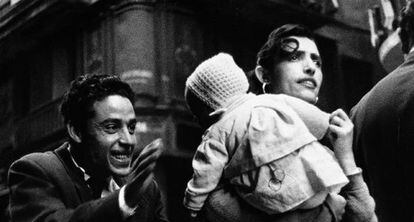 Barrio Chino from 1958 to 1960.Photo by Joan Colom
Barrio Chino from 1958 to 1960.Photo by Joan ColomGift of a lifetime: Colom hands over image archive
Photographer donates his life's work to National Art Museum of Catalonia
Joan Colom, one of the great figures of what came to be known as Spain's New Photography Avant-Garde, has donated his entire archive to the National Art Museum of Catalonia (MNAC). The collection comprises nearly 9,500 photographs, as many negatives, a 25-minute film of the entire material and a great many documents.
So ends a process that began over a year ago and included some moments of tension, especially after the life's work of another Catalan photographer, Agustí Centelles, was sold to the Culture Ministry and deposited in the Archives of Salamanca, rather than kept in the region.
"This is a historical moment; events of this nature are few and far between," said Miquel Roca, chairman of MNAC's board of trustees, as he thanked a visibly moved Colom for "his generosity, which is completely unselfish and without strings attached."
This of course does not mean there will be no compensation for the 90-year-old Colom. The Catalan culture department is negotiating a life pension for him and his family, the amount of which has not yet been made public. In any case, "it is not comparable with the real value of the archive," said Roca.
MNAC director Pepe Serra said Colom's work would "be showcased inside and outside the museum, in a national and international context." He also revealed a major Colom exhibition would soon be mounted and that its curator would be announced after the summer, when the museum presents the 2013 season.
Both Serra and David Balcells, photography curator at MNAC, insisted that the incorporation of Colom's work into the museum's photography holdings "opens new perspectives." They also underscored the excellent state of conservation of Colom's work, as well as the photographer's meticulous care in preserving his archive in good order - possibly a consequence of the fact he worked an accountant all his life.
Yet not all critics and colleagues from the same period - Oriol Maspons, Francesc Català Roca, Xavier Miserachs, Colita, Leopoldo Pomés, to name a few - shared his technique of not looking through the viewfinder so his subjects would not realize he was aiming his camera at them; he later selected the framing during the developing work. This system allowed him to capture images of prostitution and of Barcelona's notorious Barrio Chino that have remained impactful throughout the years.
An atypical character and an atypical photographer, Colom was praised as one of the greats of Spanish postwar photography, then largely forgotten again after 1964, as a result of a lawsuit brought against him by a prostitute who recognized herself in a photograph from the book Izas, rabizas y colipoterras , which included texts by Camilo José Cela - an innovative collaboration between a photographer and a writer.
The scandal caused by the book and the lawsuit pushed Colom into a depression and he quit photography until the early 1990s, when he began working in color.
His institutional comeback began in 1999, when the MNAC reproduced El carrer , his only solo show in Barcelona during his earlier period. That original exhibition, organized by Sala Aixelà in 1961, brought together a collection of shots taken between 1958 and 1960 in the Barrio Chino, and their quality awarded him a central spot among the Spanish photographers of his generation.


No comments:
Post a Comment